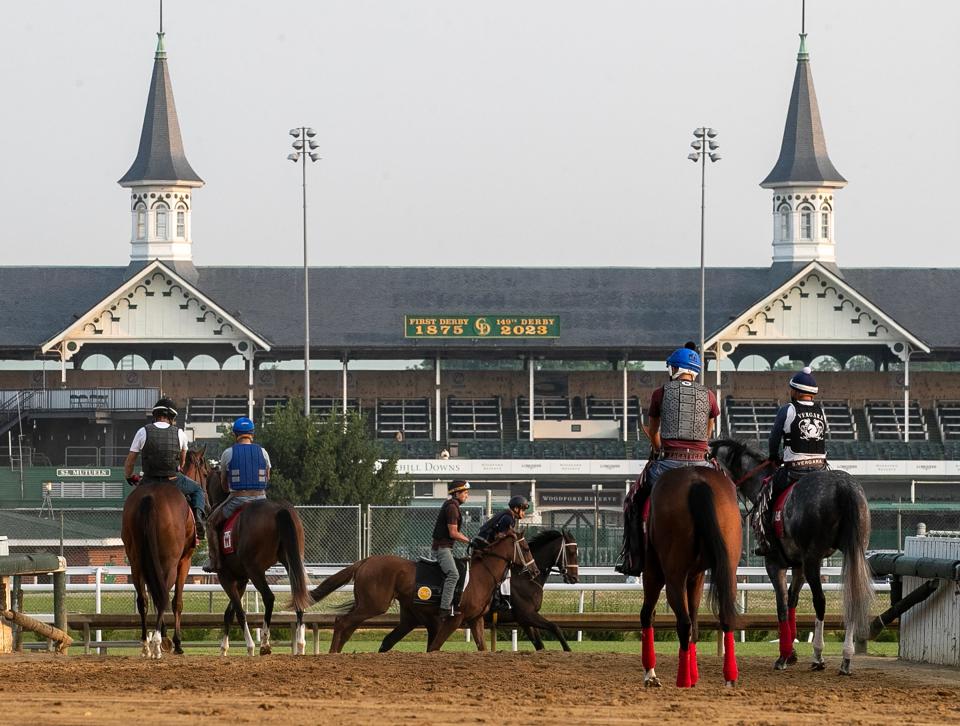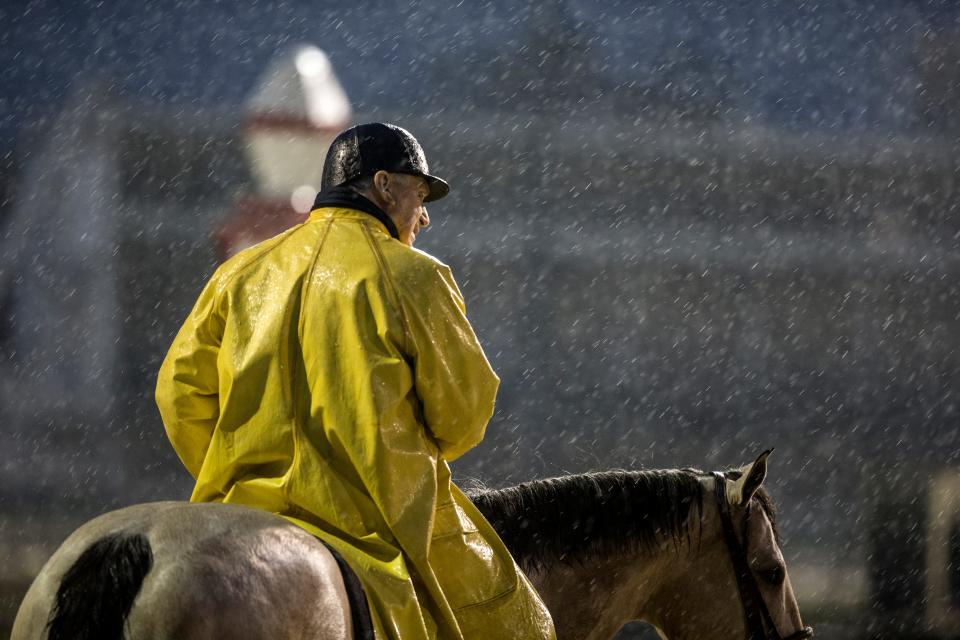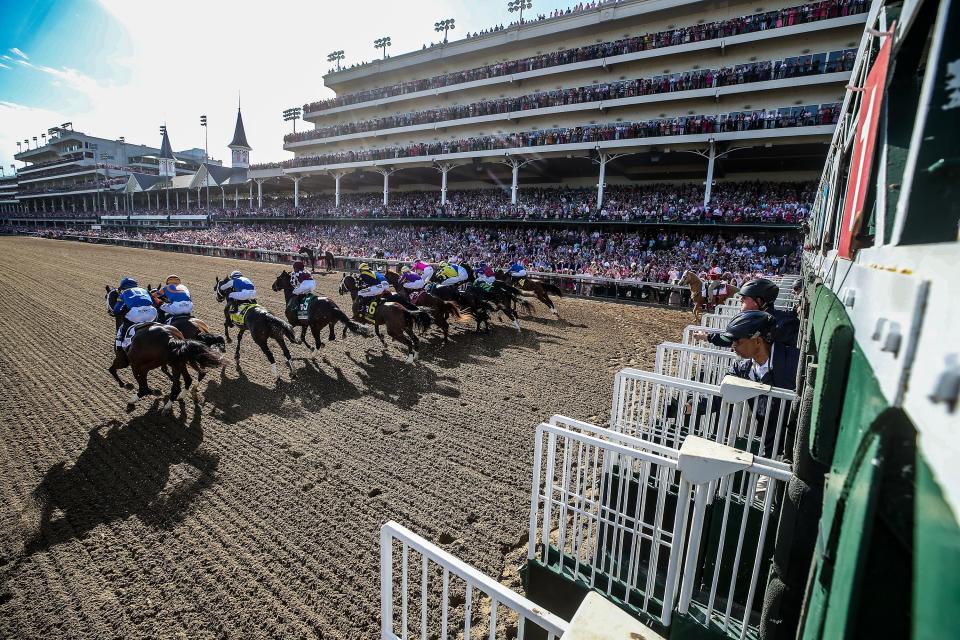Churchill Downs released 'low-hanging fruit' safety rules after 12 deaths. Will they help?
This story was updated to clarify how purses are split and awarded to owners and trainers.
HENDERSON, Ky. — Tommy Vance's cell phone continued to buzz in his hand.
"This is someone else who saw the news and wants to know why," he said.
State veterinarians had scratched two of the three horses he shipped to Ellis Park for the relocated Churchill Downs Spring Meet. Racing hadn't even started.
Vance, a third-generation horse trainer, spent the morning responding to owners who wanted to know why Catty Cruise, a chestnut filly, and Wesleyan, a dark bay gelding, were scratched.
Western Kentucky is where Vance got his start. At just 3 years old, he would hang around the backside of Ellis Park with his father and grandfather, both horse trainers.
But today, he's "flusterated." That's a mix of frustrated and flustered, a part of Arkansas that remains in him coming through in one word.
It's been an ever-changing eight weeks for trainers who race thoroughbreds in Kentucky. Eleven of them lost horses in just over a month at Churchill Downs.
The deaths of the Derby dozen put a spotlight on the already highly-regulated job trainers do, which for the last 20 years has called for a decrease in race-day medications and an increase in testing to the picograms, or one trillionth of a gram.
"That's like finding a grain of salt in a swimming pool," a horse veterinarian told the Courier Journal.
Then, Churchill — the very track trainers grew up loving and still publicly adore — put out new safety initiatives all aimed at the horses and horsemen. This is despite the fact that they don't know what caused the deaths and had two track experts analyze the famed dirt following concerns.
The initiatives took away money, restricted starts and provided more standards for a horse's poor performance.
"These initiatives were the low-hanging fruit. It's something Churchill could push out easy and institute immediately," a source with intimate knowledge of the backside at Churchill Downs told The Courier Journal.
Churchill Downs did not respond to multiple Courier Journal interview requests about the safety initiatives.
In an early June interview with an NPR station in Washington, D.C., Tonya Abeln, vice president of communications at Churchill Downs spoke about the new initiatives.
"Certainly we are not suggesting that was something that lead to these fatalities," she said when talking about the eliminated incentives. "But in an effort to fine-tune every single practice we, certainly took that into account as a possibility so we paused those."
More than a dozen trainers, who regularly work horses on the backside of Churchill Downs, wonder what the "safety initiatives" really protect.
"It's not for safety," said Wayne Catalano, a three-time Breeders' Cup-winning trainer. "They had the public, the national media paying attention. They had to come up with something — 'Ok, Here's what we're doing to change things' — to look like they're doing something different."
“We were using data to make a decision that will potentially help a horse in the future,”Farmer said. “It directly would have affected one, which I get is not a large number, but going forward if this helps 2 or 3 horses in a year, in my mind that’s successful.”
The new safety initiatives would have only impacted one of the 12 dead horses: Kimberley Dream. More on that later.
“We were using data to make a decision that will potentially help a horse in the future,” Dr. Will Farmer, Churchill Downs' equine medical director, said. “It directly would have affected one, which I get is not a large number, but going forward if this helps 2 or 3 horses in a year, in my mind that’s successful.”
First, what are the four new initiatives?
Restricting horse starts
Initiative: Restricting the number of starts per horse to four starts during a rolling eight-week period.
Trainers are calling this the Beverly Park rule.
Beverly Park was the winningest horse in 2022.
That's because he ran 30 times — twice with just five days between starts. He finished first in 15 of those races.
"Did he ever pull up lame?" said an assistant horse trainer. "Obviously not."
Few trainers race a horse this much, but in 1935, as a two-year-old bay, Seabiscuit ran 35 times, which would now be considered a heavy schedule and uncommon.
Beverly Park, who continues to race, already has seven starts this year, with three first-place finishes.
"That initiative's not going to affect anybody." an experienced horse trainer told The Courier Journal. "I mean one guy out of 1,000 back here."
That's the common refrain of more than a dozen horse trainers The Courier Journal spoke with, who agreed to speak on the condition of anonymity because of concern their comments would upset the very track that allocates them stalls.
"Good luck finding that many starts in a condition book," said Ron Moquett, a horse trainer that won the Breeders' Cup Sprint, a Grade One, in 2020. That means to find race conditions that are right for running the horse, a horse can't just stay at one track for a whole meet but be shipped to tracks across the country, which trainer Norman Cash did with Beverly Park.
Ineligibility for poor performance
Initiative: Ineligibility standards for poor performance. Horses that are beaten by more than 12 lengths in five consecutive starts will be ineligible to race at Churchill Downs until approved by the Equine Medical Director to return.
Just like the previous initiative, trainers agree this rarely happens.
But there's always one exception. That exception is Kimberley Dream.
The 7-year-old mare was euthanized May 27 after she pulled up in a race at Churchill Downs. In the horse's last five outs, she was beaten by a combined 130 lengths. Just prior, however, she finished second by one length in a starter allowance race.
Multiple trainers said the mare was being run in races above her level.
This happens when a trainer wants a horse to gain experience. The horse gets to run in a live race. The owner gets to keep their horse. The trainer trains the horse another day.
Trainers called this initiative "ludicrous" and "clearly aimed at the trainers" because it claims that they are running bad horses to make money.
What it doesn't say, trainers told The Courier Journal, is that before a horse ever leaves a gate, it is checked four different times: once by the trainer's veterinarian while in its stall, once by the KHRC vet before it heads to the track, once by another regulatory vet that oversees the paddock and a fourth by the track vet and KHRC vet while being loaded into the starting gate.
So who, more than a dozen horse trainers asked, is allowing "lame" horses to run?
"The vets have the discretion to stop this prior to the race," a separate trainer, with four decades of experience at the track, said.
There's also a state law that says the track steward "may refuse the entry of any horse by any person."
Even if anyone were trying to run lame horses, multiple levels of safeguards have been in place for a long time to prevent this from happening.

In mid-June, the New York Racing Association, a quasi-governmental private entity that runs the three major tracks in the state, followed Churchill's lead and announced the same two "equine safety initiatives."
It was during an emergency town hall meeting last month, that Churchill Downs announced the two equine safety initiatives. It wasn't until near the end of the meeting, trainers say, the initiatives aimed at them were mentioned.
All of the trainers The Courier Journal spoke with felt that by announcing these initiatives, the track insinuated that trainers were to blame.
"I believe those initiatives were very misleading to the public," said Moquett, who spoke out during the town hall. "Although I don’t believe it was on purpose, I thought that it could have been easily misconstrued by someone that isn’t in the industry daily that the reason we had the fatalities was because of the greed of horsemen who were either running their horses back too quick and/or running for the incentive program."
More than 24 hours later, just after the stock market closed, Churchill Downs Incorporated sent a press release with news they hadn't told the horsemen.
The most famed track in horse racing was shutting down racing for the first time in history.
Limit purse payouts

Initiative: Purse payouts limited to the top five finishers (used to be paid out fourth through last)
Churchill Downs began paying sixth through last place, according to Equibase, at the 2009 Spring Meet. The amount paid depended on the total purse.
"99% of the public, even owners of the horses, never knew that was happening," said trainer Tom Van Berg. "But (Churchill Down's) thought was, 'We’re going to address and make it look like we're doing something.'
"If somebody runs a horse and you get $500. Well, it costs more to run than that. The public doesn’t know that."
An analysis done by The Courier Journal found that before the track closed and moved its meet to Ellis Park, the average field size of a race was about eight horses. That means three owners/trainers no longer get paid. However, they need to cover a long list of bills, including the jockey who rode the horse and the vet who checked the horse before the race.
"Any day a human athlete plays a game, they get paid — win or lose," a horse trainer with four decades of experience.
And of the 188 races that ran during the Spring Meet in Louisville this year, only 57 included a field of 10 or more horses.
Like the other initiatives, this one doesn't address the entirety of racing but a small number of horses and trainers.
"Who is that protecting?" said a trainer during a morning workout on the backside. "You tell me any person who wants to see a decrease in their pay who wouldn't be upset about it."
"And without a field, what does Churchill have?" another trainer said, alluding to the fact that fewer horses mean a smaller field size which means less to wager on meaning fewer bets meaning less revenue for the track.
When asked how payouts affect horse safety, legendary trainer D. Wayne Lukas said it doesn't relate to current horse safety, but he had a few suggestions for the money that used to be paid to horses finishing lower than fifth.
"Is it going to research? Is it going to rehab of other horses? Is it going to retirement facilities?" Lukas, who has won 20 Breeders' Cup and 14 Triple Crown races, said. "I’d be more interested if they’re going to take it away from the owners, then give it back to them in some other manner."
Pause on track-based incentives

Initiative: A pause on track-based incentives, such as start bonuses for trainers
The bonuses for trainers began two years ago. The track gave them $300 per horse that runs. This year, during Derby Week, that increased to $1,000.
The racetrack started bonuses because purse money was available, plus other tracks, including those in California, offer the incentive, according to multiple sources with knowledge of the industry beyond Kentucky.
What does the pause on track-based incentives mean for trainers?
Trainers like Steve Asmussen and Brad Cox train hundreds of horses, meaning they have more horses to choose from to fit a race condition. They often put multiple horses in a race. Consider them like the Fortune 500 companies of horse racing.
Then there are horse trainers like Walter Bindner and Troy Newton, who combined, train less than a dozen horses. They're like mom-and-pop shops of horse racing.
The track-based incentives helped out the small trainer. A trainer is like a daycare owner and a coach - all in one. They care for the horses and train them. They also run a small business of groomers, hot walkers and farriers, plus other costs including feed and veterinary care.
And the industry is losing horse trainers, since 2000, at a rate of 254 per year.
"I don’t know of a trainer worth his salt that entered a horse because of that," Lukas said of the bonus. "I don’t have any owners that give a rat’s ass about the $1,000 either. I don’t think it’s an incentive for safety. I don’t think it’s got anything to do with that."
When a horse runs, the winning owner takes home on average 60 percent of the purse.
Of that, the trainer takes home, generally 10 percent, for finishing first through third. Some trainers charge no matter what place the horse finishes. Others don't charge beyond third. And some like Cox, the winningest trainer so far this year, charge a higher percentage.
But every trainer the Courier Journal spoke with said they don't know another trainer who would run a lame horse to collect $300. And even if they wanted to, how would that horse get past the four vet checks?
Trainers are waiting for answers they know will never come and less money — that may make more of them leave the game. They also hope future initiatives aren't made just to please a public that's never stepped in a stall or animal rights activists that have said their goal is to end horse racing.
Stephanie Kuzydym is an enterprise sports reporter, with a large focus on the health and safety of athletes. She can be reached at skuzydym@courier-journal.com. Follow her for updates on Twitter at @stephkuzy.
This article originally appeared on Louisville Courier Journal: Churchill Downs initiatives to keep horses safe explained

